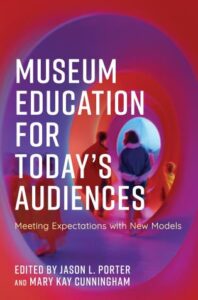Museum Education for Today’s Audiences: Meeting Expectations with New Models, edited by Jason L Porter and Mary Kay Cunningham. Lanham: Rowman and Littlefield, 2022.
REVIEWED BY SYDNEY COYNE
 In the aftermath of 2020, museum professionals responded to drastic shifts in the field, reimaging their uses of technology and approaches to social inequities. Museum Education for Today’s Audiences: Meeting Expectations with New Models, edited by Jason L. Porter and Mary Kay Cunningham, provides a valuable resource for professionals within informal education institutions. Compiling the research and experiences of twenty-nine contributors with connections to education, Museum Education for Today’s Audiences provides examples of how to creatively serve communities and collaborate with external individuals, groups, and institutions.
In the aftermath of 2020, museum professionals responded to drastic shifts in the field, reimaging their uses of technology and approaches to social inequities. Museum Education for Today’s Audiences: Meeting Expectations with New Models, edited by Jason L. Porter and Mary Kay Cunningham, provides a valuable resource for professionals within informal education institutions. Compiling the research and experiences of twenty-nine contributors with connections to education, Museum Education for Today’s Audiences provides examples of how to creatively serve communities and collaborate with external individuals, groups, and institutions.
In the first section, “Changing Expectations of Visitors: Inclusion, Participation, Technology,” the authors focus on collaboration as a way to engage visitors and facilitate learning. This section provides a variety of examples of shared authority and community partnerships, such as one between Hammer Museum educators Theresa Sotto and Hallie Scott and psychiatrist Enrico Castillo. These projects and partnerships have lasting impacts, as identified by a group of UCLA psychiatry residents after a museum-led cultural awareness activity (12).
The second section, “Training and Educator Preparation,” addresses internal museum education changes in a post-pandemic world, as well as progress that has yet to be made. This section provides information on LGBTQ+ inclusion, civil engagement, family learning, museum studies university programs, decentralized authority models, and professional development. Responding to post-pandemic changes in museum staffing and programming, authors like Jason Porter and Mary Kay Cunningham discuss the importance of adaptability and transferable museum skills, encouraging emerging museum professionals to consider working with or in “non-museum entities” (131). An array of helpful activities and visuals are provided for professionals to use for group training or personal reflection, like the “Gender Unicorn” resource offered by Mac Buff (85).
Finally, in “New Models: Anticipating the Future,” the authors suggest where museum educators should push for change. Not only do authors present new ways of thinking about the visitor experience, but they also address the urgent need for museums to collaborate and take action with the communities that they reside within. This section of the book provides examples of collaborations with Indigenous communities, new ways of approaching childhood education through free play, human-centered problem-solving, neuroscience and the visitor experience, Critical Race Theory application, responses to COVID-19, and institutional perspective shifts. For example, Tomoko Kuta discusses changes in children’s museums and innovative ways of encouraging free play without parent facilitation, including commissioning contemporary artists to create works that encourage children to independently interact with each other (189).
Although this collection was impressive in its scope and depth, several authors were not transparent about their research results. When discussing the outcomes of their projects and research, they did not specify the number of participants in their surveys, the questions that were asked, or how participants answered. For example, a clear table or graph with survey results would have served Chapter I’s discussion of the psychiatry program’s effectiveness well. In Chapter II’s discussion of the National Oratory Fellows Program, an evaluation is mentioned; however, the number of participants and the content of the evaluations are not articulated. Including this information would have bolstered both the authors’ credibility and the program’s transformative effects.
Another point worth noting is that there are missing topics and voices. Important topics, like decolonization, are not discussed in this book. Of course, the scope of any resource has to be limited at some point. However, I felt that chapters like Chapter IX, which discussed decentralized authority, may have benefited from discussing the role that decentralizing authority could play in shared authority, community collaboration, and decolonization. Connecting these projects to other pressing matters within the museum field would have made them even more relevant for today’s museum educators. Along the same lines, there were missing voices. The book is missing chapters from both front-line educators and teachers, two essential groups. In leaving these groups out, this book does not discuss the needs and recommendations of front-line educators and teachers, two groups that interact often within the museum. A chapter that included these perspectives would have strengthened the effectiveness of the other projects and resources. While the editors do acknowledge the gaps in their work, it is a weakness of the resource, nonetheless. On the other hand, this does leave room for future researchers and educators to pursue these missing topics and include the missing voices.
In general, the authors of Museum Education for Today’s Audiences, who hail from backgrounds in museum consultation, bioscience, art education, and more, provide an impressive collection of resources for not only museum professionals, but also the broader cultural sector. Authors provide templates and real-world examples of their proposals in action, reflecting critically on their own work and proposing possible improvements. Despite its few weak points, Museum Education for Today’s Audiences is an important resource to add to the museum educator’s toolkit. These authors provide insights into the previous work and research of museum professionals, and their focus on museum work after 2020 provides a helpful guide for navigating the post-pandemic museum world.
Sydney Coyne is a first year MA student in the IU Indianapolis Museum Studies Program.

